 United Kingdom (1890-1910):
United Kingdom (1890-1910): HMS Centurion, Barfleur, Renown.
WW1 RN Battleships
HMS Dreadnought | Bellerophon class | St. Vincent class | HMS Neptune | Colossus class | Orion class | King George V | Iron Duke class | HMS Agincourt | HMS Erin | HMS Canada | Queen Elizabeth class | Revenge class | G3 classMajestic class | Centurion class | Canopus class | Formidable class | London class | Duncan class | King Edward VII class | Swiftsure class | Lord Nelson class
Invincible class | Indefatigable class | Lion class | HMS Tiger | Courageous class | Renown class | Admiral class | N3 class
The British forgotten second rate battleships
The Centurion-class battleships are now an example of the forgotten Anglo-Russian naval rivalry of the late XIXth century. These were a class of pre-dreadnought battleships of the Royal Navy dating back from the early 1890s. Unusual, they were second-class battleships which service was short, ending years before WWI broke out. Their demise was largely due to a very specific role: Hunting down the large russian armoured cruisers Rossia and Gromoboi, designed specifically for commerce raiding against British assets in 1890. Speed was the deciding factor in their design, and the Centution and Barfleur were as a result less heavily armed and armoured than common first-class battleships of the time. They were also designed for speed and long range, and service abroad, even “tropicalized”. The Russian in response started their own Peresvet class second-rate battleships in turn. The third ship comparable was HMS Renown (1895), integrated here for practicality, was an interesting upgrade of the Centurion design and her own class.
Completed in 1894, Centurion and Barfleur spent most of their careers assigned in the China Station (Centurion was even its flagship) and Mediterranean Fleet. They participated in the suppression of the Boxer Rebellion in mid-1900 and were rebuilt in 1901-1905 to be modernized, but placed soon in the Reserve Fleet from 1905 since new cruisers made them obsolete. Barfleur became flagship of the reserve fleet’s Portsmouth Division but both were ultimately decommissioned in 1909, sold for scrap. HMS Renown served a bit longer, until 1914, as a stoker training ship, after service in several stations like the other two. Being all three largely an experiment, never repeated but for foreing sales (The 1903 Swiftsure class -ex-Constitution & Libertad) as they were indeed less cosly than 1st line battleships.
Centurion saw extensive service on the China station from 1894 to 1901 and from 1903 to 1905, being flagship during the carlier period. Barfleur served in the Mediterranean from 1895 to 1898, and on the China station
from 1898 10 1902. Both ships spent their later years in home waters. On her side, Renwn was transferred to Devonport DYd in 1896 for final fitting out, she served as flagship to Vice-Admiral Sir John Fisher on the North America and West Indies station from 1897 to 1899, and in the Mediterranean from 1899 to 1902. The main deck 6in guns were removed in 1902 when she was fitted out to carry the Duke and remaining 6in guns were removed during her 1904/5 refit prior to taking the Prince and Princess of WWales to India. In reserve 1902-04 and 1906-07, Renown served as a stokers TS at Portsmouth from 1909 until 1913.
Design in detail
These ships were second class battleships constructed for service on the China and Pacific stations, countering the Russians at Port Arthur. They were virtually small editions of the Royal Sovereign; The reduction in size was mainly for economic reasons with regard to both construction and running costs. Designed with a shallow draught, for navigation on Chinese rivers, they shipped a comparatively light armament, had a high speed and a high endurance (6,000 nm at 10kts compared with 4700 nm in the Royal Sovereigns) and were fitted with wood and copper sheathing for tropical service.
Their value was limited as they could not face first class battleships (like those in Europe) but were fast enough to escape from them, and still could be employed against slow armoured cruisers at the time of their completion, in particular the Russian vessels stationed Vladivostock and the “fast battleships” of the Pereviet class.
guns with 6in guns, all of which were mounted in 5-in armoured casemates. Six 6in guns were fitted on the main deck and four on the upper deck. This modification added considerable extra weight and drastic weight saving was achieved by replacing the foremast with a light signal mast and.
Hull construction
The Centurions measured 390 feet 9 inches (119.1 m) overall, down to 360 ft (109.7 m) in perpendiculars, for a beam of 70 feet (21.3 m), normal draught of 25 ft 8 in (7.82 m) up to 26 feet 9 inches (8.2 m) deeply loaded. They displaced 10,634 long tons (10,805 t) normal, 11,200 long tons (11,400 t) fully loaded and their metacentric height was 4.1 feet (1.2 m) FL. Since where they would operate, docking facilities large enough were rare, so their steel hulls were sheathed in wood and copper to reduce biofouling and therefore reduced the need of hull maintenance. Normal crews comprised 620 officers and ratings as completed in 1895, but 600 after being rebuilt with a more rational armament. They were considered good steamers and good seaboats and rolled predictably, making good artillery platforms. Otherwise, their general design was very close to standard pre-dreadnought battleships, largely symetrical.
Armour scheme
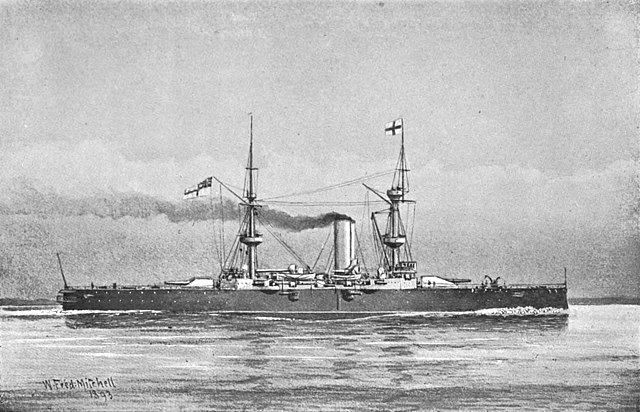
HMS Centurion, Brassey’s Naval Annual 1893
To gain time, armour was disposed as in Royal Sovereign class. The main belt was 200ft long by 74ft deep with 5 feets below the waterline, 12 inches amidships reducing to 10-in fore and aft, and 9-in at the ends. The main belt was closed by 5-in bulkheads, the upper belt by 3-in bulkheads. Barbettes were 9-in above the upper belt and 8-in to 5-in behind it. Decks were 2-in over the belt and 2-in fore and aft of it. The upper belt avoided damage to boilers, and greatly increased all other unnecessary fittings for the gun houses and casemates.
Harvey NS was used for the protective deck, the remainder being compound structures with reduced efficiency. As a result the increase in displacement with Harvery armour was only 80 tons.The main belt run for 200 feet (61.0 m) long amidships, 7 feet 6 inches (2.3 m) high, 5 feet (1.5 m) below (normal load). Fore and aft oblique bulkheads connected the belt armour to the barbettes, creating the citadel. The upper strake above the waterline belt was 7 feet 6 inches high, covering the side between barbettes for and aft, up 10 feet (3.0 m) above the waterline. The lower armored deck extended from the 5-inch (127 mm) bases of the barbettes to the bow and stern.
- Waterline main belt 9-12 inches (229 to 305 mm)
- Waterline main belt bottom edge 8 in (200 mm)
- Waterline main belt upper strake 4-inch (102 mm) Harvey armour
- Citadel Oblique bulkheads 3 inches (76 mm) Harvey armour
- Armor deck 2x 2 inches (51 mm) mild steel
- Lower deck 2.5-inch (64 mm)
- Barbettes 9-in, down to 8-in below the citadel
- Gunhouse cover 6-in (150 mm) nickel steel
- Casemates 4-inch faces, 2-inch sides, Harvey armour
- Conning Tower 12 in forward, 3 in aft.
The Centurions were the first British battleships fitted with an armoured hood (“gunhouse”) indeed, above the barbettes. They protected the large gun crews and protected the frontal arc, but not the rear, to ease work of the loaders. This cover rested solidary to the barbette. This was a first step towards modern gun turret.
Powerplant
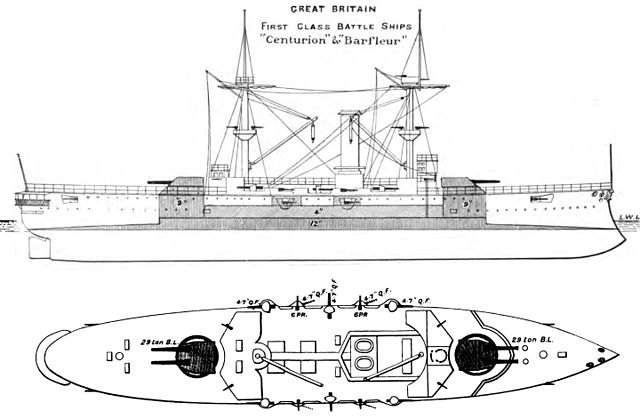
Brasseys diagram
As designed, they were fitted with about the same propulsion system as in the Royal Sovereign, with two three-cylinder vertical triple-expansion (VTE) steam engines. Each drove a single propeller while steam came from eight cylindrical boilers, at a working pressure of 155 psi (1,069 kPa; 11 kgf/cm2). As designed the powerplant was rated at 9,000 indicated horsepower (6,700 kW) – Compared to the Royal Sovereign, it was less (11,000 ihp/8,200 kW), but still enough to allow them to reach 17 knots (31 km/h; 20 mph) in natural draught.
In fact their engines proved to be slightly more powerful than anticipated, as they reached 17.1 knots (31.7 km/h; 19.7 mph) from 9,703–9,934 ihp (7,236–7,408 kW) in sea trials. Forced draught were discouraged as they often damaged the boilers. The reconstructed Centurion made 16.8kts 1901-03 and Barfleur in 1902-04, based on 9,270 ihp and for Barfleur 16.75 kts based on 9,137 ihp under natural draught. Both vessels were good steamers and good seaboats. Under natural draught Centurion made 17.5kts with 9,703ihp and Barfleur 17.1kts with 9,934ihp. Under forced draught they produced 13,214ihp and 13,163ihp respectively, giving an approximate speed of 18.5kts, still in forced draught.
They also carried up to 1,420–1,440 long tons (1,440–1,460 t) of coal, enabling up to 5,230 nautical miles (9,690 km; 6,020 mi) at 10 knots, better than for the battleships at 4,720 nmi. So they were mor less equivalent in speed and cruising regime to their opposite, the Peresvet class, although the latter were a tad faster.
Armament
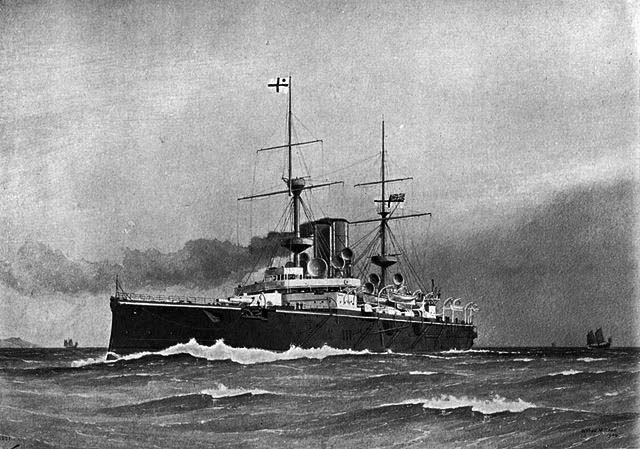
HMS Centurion 1892
The main armament was provided with all round loading, allowing the use of circular barbettes of less weight than the pear shape previously used. The gun mechanism and crew were more exposed than in earlier vessels, and a revolving unarmoured hood with an open back fitted over the barbette, this being the origin of the armoured gun houses, and referred to as turrets.
- Two twin 10 in (254 mm) guns
- Ten casemated single 4.7 in (120 mm) guns
- Eight single 6-pdr (2.2 in (57 mm)) guns
- Twelve single 3-pdr (1.9 in (47 mm)) guns
- Seven 18 in (450 mm) torpedo tubes
Main: BL 10-inch Mk II
-The BL 10-inch Mk II-IV naval gun (254 mm) was interchangeable between the Centurion class, Victoria class, Renown and Devastation class as modernized in 1890. It originated with the Committee on Ordnance in 1879 ordering both a 10.4-inch and new 9.2-inch BL guns to transition from muzzle-loading guns and the 10.4-inch came earlier in 1885, firing a 500-pound projectile. The Mk IV emerged in 1889 but the RN ultimately discarded the 10-inch in favour of the 9.2-inch and 12-inch. A 29 tons barrel and breech piece of ordnance, it was capable of firing 500 pounds (226.8 kg) shells at 2,040 feet per second (622 m/s), up to 10,000 yards (9,100 m). Note: In 1906, it was planned to equip Centurion with Siemens Mark II rangefinders, but they are not listed in the 1914 source. There are no reference for Barfleur anyway. Both ships were never fitted either with a Dreyer Table before 1914, they were low in priority.
Secondary: QF 4.7-inch Gun Mk II
This new ubiquitous replaced the older, slower 5-in BL, optimised for modern smokeless propellants (Cordite) and with rapid reload, with a shell slightly lighter, with better range. Not only it saw action from many British, Italian, Japanese, Canadian navies (and otrhers) but also as a field gun, from the Boer war to WWI. Barrel & breech weight 4,704 lb for 189-inch bore (40 cal). Manned by ten men, using a single motion interrupted screw, Separate loading with AP/HE rounds, with a rate of fire of 5–6 rounds per minute, 1,786-2,150 fps muzzle velocity at 10,000 yards (9,100 m) and up to 12,000 yards at 24°.
Tertiary: Anti-TB 6 & 3 pdr
In total, Twenty light guns were initially fitted, Eight 6-pdr (57 mm, 2.2 in) in hull casemates four and aft, and four on the broadside, masked. They fored a 45-pound (20 kg) shell at a 2,125 ft/s (648 m/s). The lighter 3-pdr (47 mm Hotchkiss) were mostly placed in the superstructures, four in the bridge forward and aft, four in the main military tops, and the last in the forward second military top. They fired a 3-pound-3-ounce (1.4 kg) shell at 1,867 ft/s (569 m/s), both had a rate of fire of about 25-30 rpm.
Torpedo tubes:
Seven 18 in (450 mm) torpedo tubes seems a lot for a battleship, but at the time, it was seen as a close attack or defense weapon if the rest was knock out and to be used in close melee engagement. Useful range was in reality well below 10,000 yards, and two were placed on each broadside above water plus one in the stern, also above waterline, and one on each broadside underwater. Five above-water, two submerged 18-in tubes were provided in the original design. The above-water were placed at corners of the armoured citadel, 50° or 42° degrees ahead and there was one axial fixed tube astern. The two submerged broadside tubes were placed forward, depressed 1°, angled abeam with an axis 9 ft 5 in below the waterline, 2 ft 4 in above the armoured deck. In 1909, they were all removed.
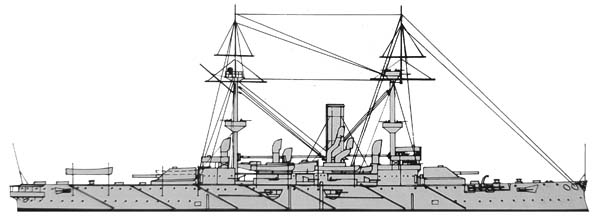
⚙ Centurion class specifications |
|
| Dimensions | 119 x 21.3 x 7,82 m (391 x 70 x 26 ft) |
| Displacement | 10,634t long tons (10,805t) |
| Crew | 606-620 |
| Propulsion | 2 shaft VTE engines, 8 cyl boilers, 9,000 shp |
| Speed | 17 knots (31 km/h; 20 mph) |
| Range | 5,230 nmi (9,690 km; 6,020 mi)/10 knots |
| Armour | Belt 9–12 in, Bulkheads 8 in, Decks 2–2.5 in, CT 12 in, Barbettes 9 in, Gunhouses 6 in, Casemates 2–4 in |
| Armament | 2×2 10-in, 10× 4.7 in, 8× 6-pdr, 12× 3-pdr, 7× 18 in TTs |
About HMS Renown
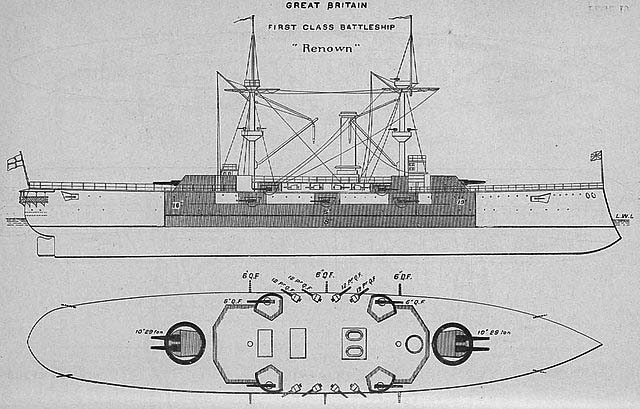
HMS_Renown_diagrams_Brasseys_1897
Renown was constructed under the 1892-1893 Estimates. She was built at Pembroke Dockyard at a cost of £751,206, laid down on 1st February 1893, launched on 8 May 1895 and completed in January 1897. Basically an enlarged version of the Centurion class ships with a heavier secondary armament, all Harvey NS armour and increased speed and endurance. She was almost 2,000 tons heavier than the earlier vessels, with and output of 10,708ihp and 19.75kts while her length and beam being were increased to maintain shallow draught. The use of NS allowed for some thinning of the main belt and barbettes,without any loss of protective value in comparison with compound plates. Displacement: 12,350t fully load, 380ft pp. 408ft oa in lenght.
Renown’s armour protection
Protection was also improved by increasing the thickness of the upper belt, which substantially added to the effectiveness of the side armour, and by sloping the outer edge of the protective deck over the citadel, to meet the lower edge of the belt. This latter arrangement served to deflect shells which penetrated the belt and reduced the area likely to be flooded by waterline hits. The main belt was 210ft long, thick amidships and 6in at the ends, and enclosed by 10-in forward and 9-in after bulkheads. The upper belt was closed by 6-in bulkheads. The deck over the main belt was 2-in on the flat and 3in on the slope, the deck fore and aft of the belt being 2-in and 3-in. The barbettes were 10-in above the upper belt and 5-in behind it.
Renown’s armament
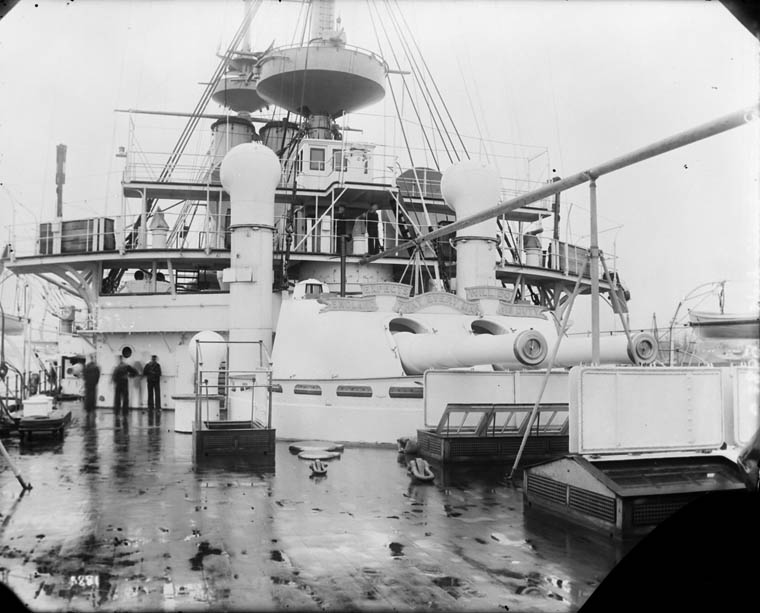
HMS Renown’s aft main artillery
All the 6in guns were fitted in casemates, six on main deck with 6in armour and four on upper deck with 4in armour. For the first time part of the 12pdr armament was arranged in a definite battery, with four guns on each side of the casemates.
Powerplant
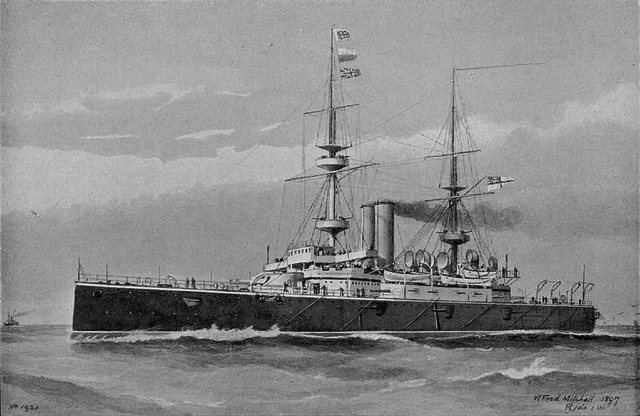
HMS_Renown_Brasseys_Naval_Annual_1897
Her Machinery compared 2 shaft Maudslay 2 Triple-expansion steam engines coupled with 8 cylindrical boilers, for a total output of 10,000 ihp (7,500 kW). HMS Renown proved to be an excellent steamer, manoeuvring well and being a good seaboat with an easy roll. On trials she made 19.75 kts under natural under forced draught with 12,901 ihp. On normal use she was capable of 19 knots (35 km/h; 22 mph). On the range side, she was capable of reaching 8,500 nmi (15,700 km; 9,800 mi) at 15 knots, doing much better than the Centurions, more than capable to oppose the Russian Peresviet class Battleships.
⚙ HMS Renown specifications |
|
| Dimensions | 125.7 x 22 x 8,3 m (412 x 72 x 27 ft) |
| Displacement | 12,865t long tons (13,071t) |
| Crew | 651-674 |
| Propulsion | 2 shaft VTE engines, 8 cyl boilers, 10,000 shp |
| Speed | 18 knots (35 km/h; 22 mph) |
| Range | 5,500 nmi (15,700 km; 9,800 mi)/5 knots |
| Armour | Belt 9–12 in, Bulkheads 8 in, Decks 2–2.5 in, CT 12 in, Barbettes 9 in, Gunhouses 6 in, Casemates 2–4 in |
| Armament | 2×2 10-in, 10× 4.7 in, 8× 6-pdr, 12× 3-pdr, 7× 18 in TTs |
Modifications
Bilge keels were added in 1896–1897 for added stability. Gun shields were removed for the fighting tops guns in 1897-1899, also to save weight. Some of these three-pounders were removed altogether in 1901, while the September 1901 reconstruction started. All the 4.7-inch guns were removed and replaced by new standard 6-inch guns, while the protection was reworked and improved. Due to the additional weight her above-water torpedo tubes were removed and aft bridge. All remaining 3-pdr in the fighting tops were repositioned into the superstructure. The barbette hoods were removed. The foremast was replaced by a light pole signal mast. Despite of this, displacement rose and speed fell by 0.25 knots. In 1906 all 3-pdr were removed and the mainmast fighting top gained a lighter platform with a basic fire-control position.
Read More/Src
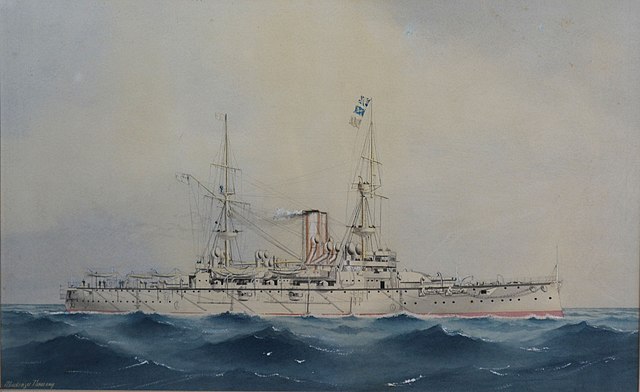
William Mackenzie Thomson painting of HM Centurion
The Centurion class on dreadnoughtproject.org
On wikipedia
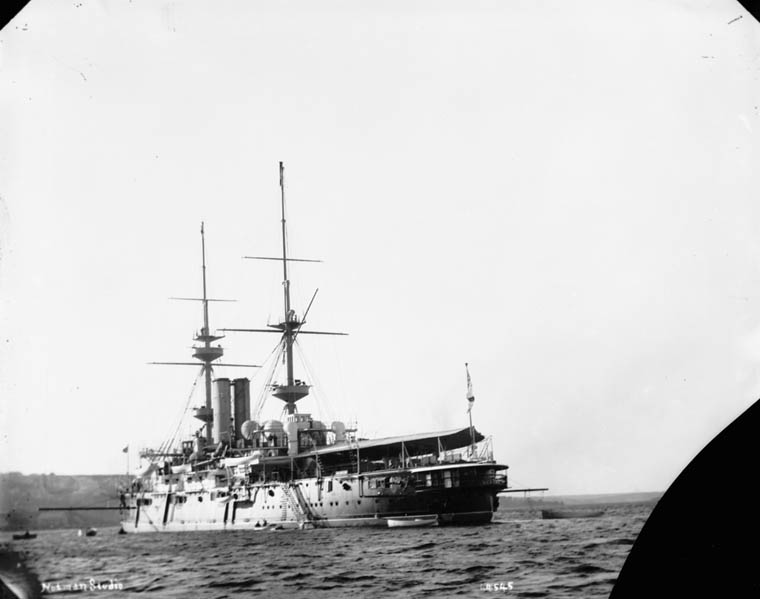
HMS_Renown_Halifax_circa_1890s

HMS_Renown_postcard_c1907
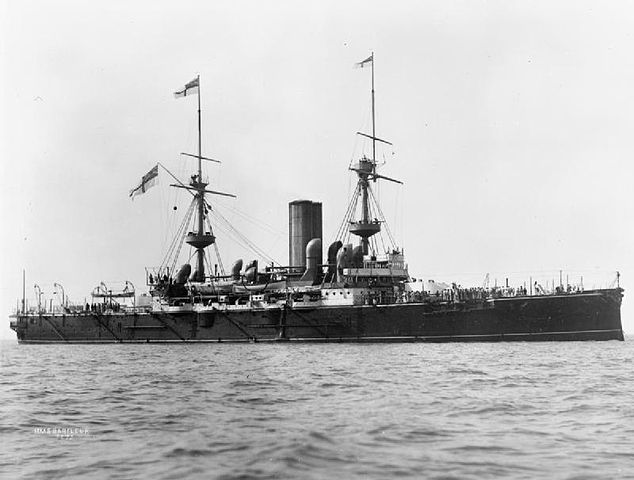
Barfleur 1895, Symonds and Co Coll.
Gardiner, Robert. Conway’s All the World’s Fighting Ships 1860–1905
Gibbons, Tony (1983). The Complete Encyclopedia of Battleships. New York: Crescent Books
Brown, David K. (1997). Warrior to Dreadnought: Warship Development 1860–1905. Chatham Pub.
Burt, R. A. (2013). British Battleships 1889–1904 (New revised ed.). Annapolis
Campbell, N. J. M. (1982). “British Naval Guns 1880–1945, No. 5”. John Roberts (ed.). Conway
Clowes, Sir William Laird. The Royal Navy: A History From the Earliest Times to the Death of Queen Victoria #7. Chatham Pub.
Friedman, Norman (2011). Naval Weapons of WWI. Barnsley, Seaforth.
McTiernan, Mick, A Very Bad Place Indeed For a Soldier. British involvement in Crete. 1897-1898, King’s College, London
Parkes, Oscar (1990). British Battleships. Annapolis.
Chesneau, Roger & Kolesnik, Eugene M., eds. (1979). Conway’s All the World’s Fighting Ships 1906–1921
McTiernan, Mick: The British involvement in the early stages of the European Intervention in Crete.
Model kits
19th-century exhibition model originally displayed in, and possibly made for, the Royal Naval College Museum, Greenwich – On rmg.co.uk coll. auctionable
1/48 builder’s model. – stefap
Kombrig 1/700 model – On steelnavy.com, by steve backer
Wartime service
HMS Centurion
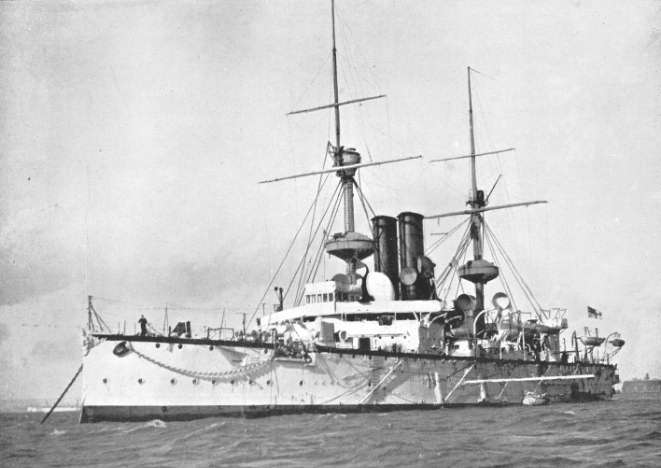
Centurion 1892
“Centurion” referred to the Roman Army rank, in tune with the Romantic era, neo-classical style and interest for antiquity; The name also had welcome martial qualities for a warship. It was however only used once afterwards, on a 1911 KGV battleship, and a planned 1945 cruiser.
She was nevertheless the sixth ship of this name, the last one being a 1844 80-gun 3rd rate ship of the line. Built at HM Dockyard in Portsmouth she was laid down on 30 March 1890 and launched on 3 August 1892, completed in February 1894 (cost £540,090), made her uyard’s engine trials, and first sea trials with the yard’s crew, then she was commissioned on 14 February, es expected for service on the China Station. Her first captain was Edmund Poë. She sailed from 2 March and arrived in Singapore on 11 April, as flagship under overall command of Vice-Admiral The Honourable Sir Edmund Fremantle. Captain John McQuhae soon took command, the relieved relieved by Captain Spencer Login on 21 March 1895.
China Station (1895-1905)
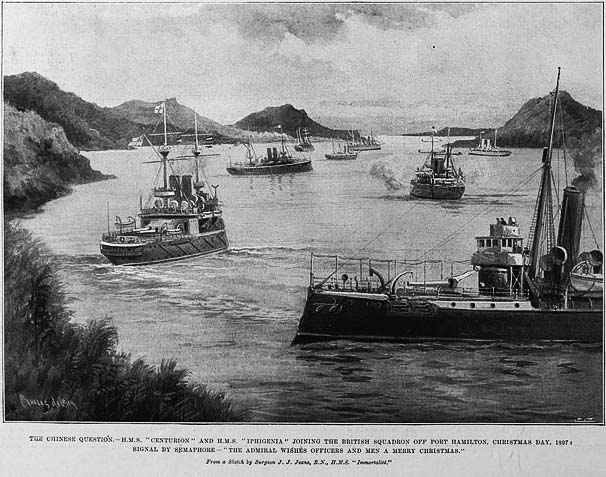
Centurion in the China station, port Hamilton, Xmas 1897
Her career had nothing notable but a training cruise stopping in several ports in the rea between China and Japan. HMS Centurion however ran aground on a sandbank at Shimonoseki, Japan by June 1896. Captain John Jellicoe became her new captain on 12 February 1898 and she hoisted the flag of Vice-Admiral Sir Edward Seymour, replacing Fremantle. In 1899 nothing much happened by the following year she took part in the Boxer Rebellion. She was part of Seymour’s expedition attempting to relieve the besieged International Legations in Peking on 10-28 June 1900. They were ambushed and defeated en route by regular Chinese troops and Boxers. Jellicoe also too part in this expedition and was badly wounded on the 21st. There were enough crew to launch other landing parties ashore, which stormed the Taku forts (16–17 June) before freeing foreign legations at Tientsin on 13–14 July.
As the situation calmed down with the Empress’ concessions, HMS centurion went through a storm on 17 April 1901 while anchored at Woosung near Shanghai. Her mooring cables snapped, letting her drifting across the bows of HMS Glory. A stationary Glory’s bow punched through Centurion’s hull, below the waterline. However since it was unpowered and slow-moving, damage was easily repaired in Hong Kong and Glory replaced Centurion as flagship in June. On the 26th, Vice-Admiral Sir Cyprian Bridge took command. The ceremony took place onboard Centurion, which then sailed back to Portsmouth aboard, arriving on 19 August to a hero’s welcome. Tthe local Commander-in-Chief, delegates and admiralry brass, a band, and a crowd pressed on the beach and pier to greet them. Admiral Seymour struck his flag on 21 August and Centurion was paid off, placed into reserve on 19 September.
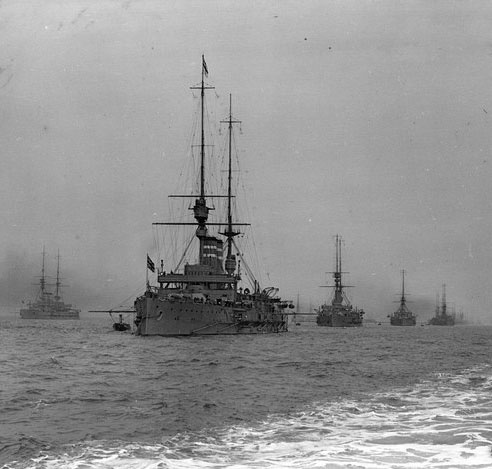
Queen’s review, Spithead
Indeed, it was intended to modernized her (see above) and her reconstruction took place at Portsmouth until 3 November 1903. Recommissioned she was scheduled to return to the China Station, departing Portsmouth on 10 November, arriving 31 December 1903. 1904 saw nothing notable but the Russo-Japanese war developing, and in 1905, the UK and Japan renewed their 1902 Alliance. This freed some British presence in these waters, so all capital ships were removed from the China Station. On 7 June Centurion and HMS Ocean departed Hong Kong for home, stopping at Singapore to meet HMS Albion and HMS Vengeance, before proceeing in formation from 20 June to the Indian Ocean, stopping at Colombo and Port Said, corssing the Canal, then stopping at Malta and Grobraltar before reaching Plymouth on 2 August 1905.
Late career (1906-1910)
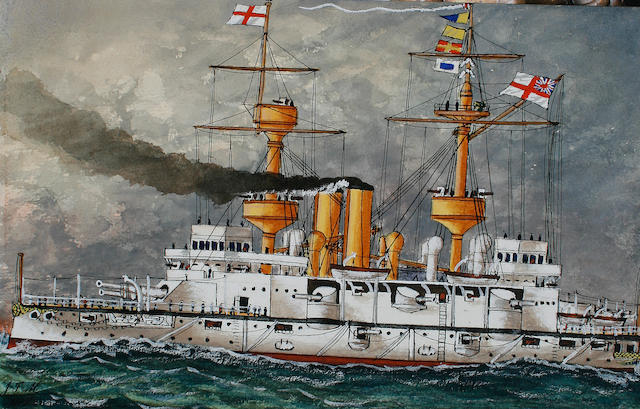
James Scott Maxwell painting of Centurion
The Royal Navy, at a time HMS Dreadnought’s construction started, reassessed the need of HMS Centurion in a new context, a possible Anglo-German naval race. Created for the asian squadron she had little use in the Home fleet, and was paid off at Portsmouth on 25 August 1906 and recommissioned with a skeleton crew in the Reserve Fleet, Portsmouth division due to her age. She nevertheless participated in combined exercises with the Reserve Fleet but also the Atlantic Fleet and Channel Fleet in between stationary service, in June 1906.
On 24 May 1907, her remaining crew was transfered to the battleship HMS Exmouth. Again with a minimal service crew she was reassigned as “special service vessel”, barrack and depot ship in the Portsmouth Division, Home Fleet. In March 1909 she was reassigned to the 4th Division and on 1st April, she was paid off for the last time, placed for sale, and sold in July 1910 to Thos. W. Ward, Morecambe BU from 4 September.
HMS Barfleur
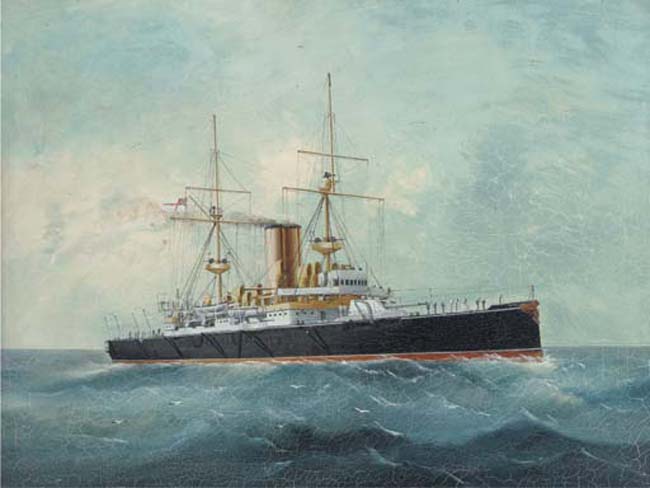
H.M.S._Barfleur_on_the_China_station
HMS Barfleur (named after the 1692 Battle) and the third ship of the name in the Royal Navy was built in HM Dockyard, Chatham, laid down on 12 October 1890, launched 10 August 1892, completed in June 1894 (cost £533,666) and to the Fleet Reserve on 22 June, only commissioned in July for annual summer fleet maneuvers. Back to reserve on 1 September she was recommissioned for good on 26 February 1895.
Mediterranean service (1895-1898)
Instead of China, she was sent for a tour of duty with the Mediterranean Fleet. Departing England on 19 March 1895, she arrived at Gibraltar on 23 March 1895, relieving the old HMS Sans Pareil. Training in Gibraltar she then sailed for Malta (arrived 27 July 1895) her final base for the Mediterranean fleet.
Soon she was stationed in Crete as a Greek uprising took off again Ottoman rule here in early 1897. On 6 February 1897 the government decided not to back up the Greeks but protect British interests there, and sent a landing party ashore at Candia (Heraklion) to restore order and protect British subjects. They were escorted aboard Barfleur until everything calmed down during the riots. But the area attracted international interest as more ships gathered here to protect their own nationals. The Austro-Hungarian Navy, French Navy, Imperial German Navy, Italian Royal Navy, Imperial Russian Navy were all prsent there as well. They at some point threatened to bombard Cretan insurgents. They sent landing parties with armed sailors and marine companies ashore, later also blockading Crete and other Greek ports to prevent reinforcements. On 15 February 1897, HMS Barfleur own landing party led to the occupation of Canea (Chania), at that time Crete’s capital city.
Chinese service (1898-1901)
HMS Barfleur departed Malta for the China Station on 6 February 1898. She was in Singapore on 4 March 1898, and proceeded to her final base, escorted by the destroyers HMS Fame and HMS Whiting to Hong Kong. On 1 October 1898, Barfleur became the new flagship of the station’s second-in-command (Rear-Admiral Charles FitzGerald) and on 26 October 1899 had a new captain, Sir George Warrender. FitzGerald was relieved by Rear-Admiral Sir James Bruce (23 December 1899).
Like her sister ship Centurion, HMS Barfleur also took part in the Boxer Rebellion, sending landing parties ashore storming Taku forts and relieving the besiege legations in Tientsin. At the time, a young Cdr David Beatty(1st Earl Beatty and future First Sea Lord) was wounded at Tientsin. In September 1900, HMS Albion relieved Barfleur as flagship and she departed Hong Kong on 11 November 1901 for Plymouth (31 December).
Home fleet service (1904-1910)
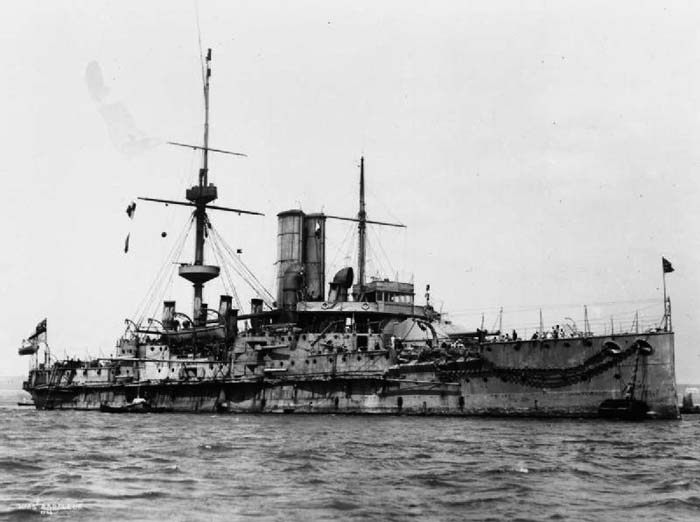
Barfleur in 1910
On 22 January 1902 she paid off at HM Dockyard in Devonport for reconstruction in Portsmouth, until May 1904, but placed in reserve afterwards. She received a larger crew to (recomm. 18 July 1904) to participate the summer annual maneuvers but accidentally collided with HMS Canopus in Mount’s Bay, 5 August 1904. Paid off on 8 September 1904 and recommissioned on 21 February 1905, HMS Barfleur carried her new crew to HMS Vengeance sent in the China Station. The two ships met in Colombo (Ceylon= on 30 March 1905, Vengeance′s crew embarked on Barfleur before going home. This was her last asian trip. Back in Portsmouth on 7 May 1905, paid off again, she stayed in reserve until 10 May 1905, recommissioned with a nucleus crew as flagship, Rear Admiral in the Portsmouth Division (Reserve Fleet). In June 1905, she took officers and ratings of the London Division, Royal Naval Volunteer Reserve in a training cruise.
On 28 November 1905 her crew was transferred to HMS Duncan, she retained a skeleton crew until she was refitted in 1905–1906 and took part in the 1906 annual summer maneuvers. In 1906-1907 she was the flagship of the Portsmouth Division. HMS Prince George replaced her on 4 March 1907 and she became “special service vessel”, Portsmouth Division, then 4th Division of the Home Fleet (March 1909).

At the 1897 Diamond Jubilee, Spithead
In June 1909 she was stricken and sold for BU, towed to the Motherbank, moored until 12 July 1910; However after being sold and while towed to the scrapyard, she became jammed between the piers of a swing bridge at Newcastle upon Tyne on 5 August 1910, nearly collapsing it. The bridge could not close, so all circulation stopped, creating a giant traffic jam. Deck fittings were cut away so she could resume at high tide her trip, and was eventually scrapped at Blyth.
HMS Renown
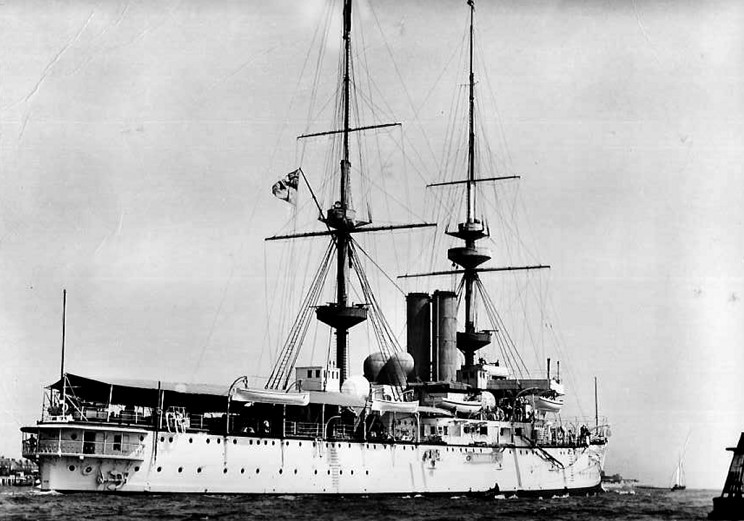
Renown in 1895 as built, starboard quarter
HMS Renown (8th ship of that name, the next one was a famous battlecruiser) was laid down at Pembroke Dockyard, 1 February 1893, launched on 8 May 1895, completed in January 1897 (cost £751,206). Her trials dragged on as defects were noted in her propeller blades, that has to be changed, and trials lasted until June. Commissioned on 8 June 1897 as flagship, Commander-in-Chief (Vice Admiral Sir Nowell Salmon) on 26 June she took part in the Fleet Review at Spithead (Diamond Jubilee of Queen Victoria), hosting the Prince of Wales. She was later attached to the 1st Division (Channel Squadron) in July for manoeuvres south of Ireland.
Mediterranean Station (1898-1902)

Renown off Halifax, Nova Scotia 1898
On 24 August she became Fisher’s flagship, relieving HMS Crescent in that role, for the North America & West Indies Station. In May 1899 she was back home for a refit and maintenance, until July. She was transferred to the Mediterranean Fleet, always as Fisher’s flagship which intervened in her design and though she would be perferct to host social events in peacetime. Captain Hugh Tyrwhitt took command on 19 March 1900 and her ship went through a small refit at Malta (February-May 1900) to meet Fisher’s requirements as a “party boat”. Her aft deck 12-pounders were relocated to the superstructure. From her recommission on 19 November 1900, she served as flagship for Fisher’s tour in 4 June 1902, but her service went on with the Mediterranean Fleet, under Arthur Murray Farquhar’s command, taking part in combined manoeuvres off Cephalonia, Morea in September-October 1902.
“Battleship Yacht” (1902-1903)
Detached from the Mediterranean Fleet back home, she was to be fitted out at Portsmouth as a “yacht” with new accomodations in order to host the Duke and Duchess of Connaught, on a royal tour of India. Her main deck six-inch guns were removed and fittings for wooden-paneled accomodations, a large semi-permanent tarpaulin dressed on her aft deck, fitting for the same on the forward deck and a band plus extra personal onboard. HMS Renown carried out this royal tour of India, from November 1902 to March 1903, before making it back to the Mediterranean Fleet in April, relieving Venerable as flagship in August and participated in manoeuvres off Portugal.
“Royal Yacht” (1904-1906)
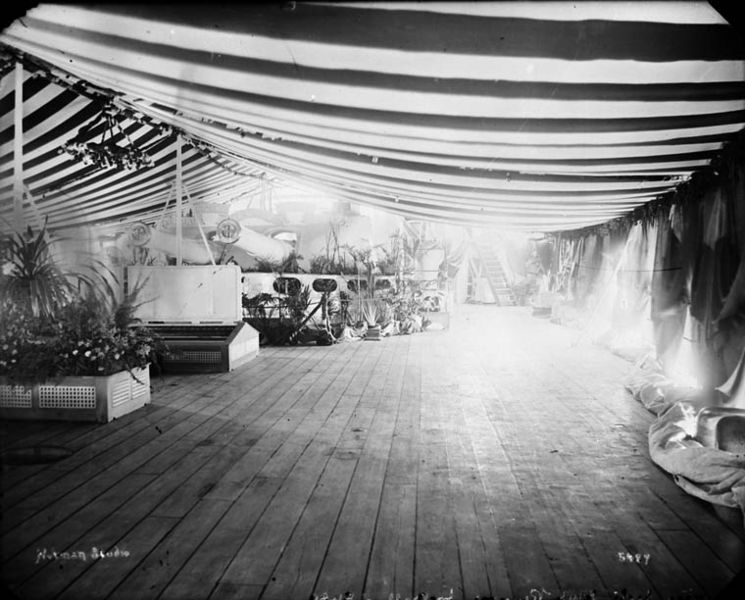
Renown’s quartedeck prepared for a ball
Placed into reserve in Devon, on 15 May 1904 with manoeuvres the next month, by February 1905, she started yet another refit, this time to configure her as a royal yacht. The remainder of her secondary armament was removed, making for extra accomodations for the King, his family, staff and extra personal, in addition to her former accommodations. With a degraded military value, she sailed out from Portsmouth on 8 October to Genoa in Italy, visiting the Italian Royal familiy, and then the Prince and Princess of Wales embarked for their own royal tour of India. During this tour, Renown was escorted by the massive cruiser HMS Terrible. HMS Renown departed at its conclusion Karachi (23 March 1906) for home. She arrived at Portsmouth on 7 May 1906, placed into reserve.
“Subsidiary Yacht” (1907-1909)
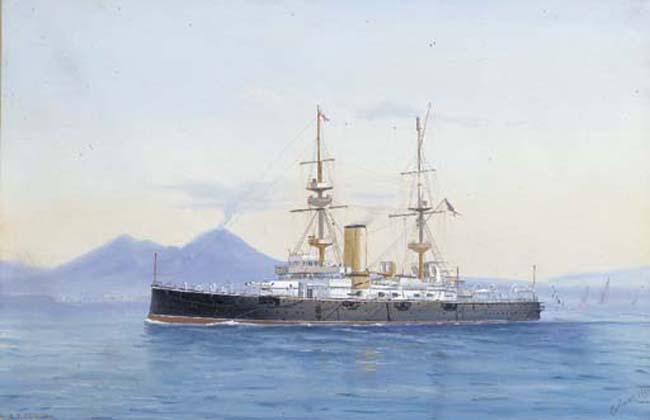
In the Bay of Naples
In May 1907, still attached to the Home Fleet she became a “subsidiary yacht” and from October, up to December 1907, cruised with King Alfonso XIII and Queen Victoria Eugenia of Spain, on their leg back to Britain, and official trip to and from the United Kingdom. Afterwards, she was versed to 4th Division of the Home Fleet and stationed in Portsmouth, from the 1st of April 1909. On 25 September she was drydocked for a refit, a full conversion as a stoker’s training ship. She was a tender to the famous HMS Victory in October. She became an accomodaion ship for King Georges V during the Coronation Review at Spithead (24 June 1911). A water tanker rammed her on 26 November 1911 but damage was light. Stricken, placed for sale on 31 January 1913, partially dismantled she was still moored in December and was sold on 1 April 1914 to Hughes Bolckow, broken up at Blyth.


 Latest Facebook Entry -
Latest Facebook Entry -  X(Tweeter) Naval Encyclopedia's deck archive
X(Tweeter) Naval Encyclopedia's deck archive Instagram (@navalencyc)
Instagram (@navalencyc)





 French Navy
French Navy Royal Navy
Royal Navy Russian Navy
Russian Navy Armada Espanola
Armada Espanola Austrian Navy
Austrian Navy K.u.K. Kriegsmarine
K.u.K. Kriegsmarine Dansk Marine
Dansk Marine Nautiko Hellenon
Nautiko Hellenon Koninklije Marine 1870
Koninklije Marine 1870 Marinha do Brasil
Marinha do Brasil Osmanlı Donanması
Osmanlı Donanması Marina Do Peru
Marina Do Peru Marinha do Portugal
Marinha do Portugal Regia Marina 1870
Regia Marina 1870 Nihhon Kaigun 1870
Nihhon Kaigun 1870 Preußische Marine 1870
Preußische Marine 1870 Russkiy Flot 1870
Russkiy Flot 1870 Svenska marinen
Svenska marinen Søværnet
Søværnet Union Navy
Union Navy Confederate Navy
Confederate Navy Armada de Argentina
Armada de Argentina Imperial Chinese Navy
Imperial Chinese Navy Marinha do Portugal
Marinha do Portugal Mexico
Mexico Kaiserliche Marine
Kaiserliche Marine 1898 US Navy
1898 US Navy Sovietskiy Flot
Sovietskiy Flot Royal Canadian Navy
Royal Canadian Navy Royal Australian Navy
Royal Australian Navy RNZN Fleet
RNZN Fleet Chinese Navy 1937
Chinese Navy 1937 Kriegsmarine
Kriegsmarine Chilean Navy
Chilean Navy Danish Navy
Danish Navy Finnish Navy
Finnish Navy Hellenic Navy
Hellenic Navy Polish Navy
Polish Navy Romanian Navy
Romanian Navy Turkish Navy
Turkish Navy Royal Yugoslav Navy
Royal Yugoslav Navy Royal Thai Navy
Royal Thai Navy Minor Navies
Minor Navies Albania
Albania Austria
Austria Belgium
Belgium Columbia
Columbia Costa Rica
Costa Rica Cuba
Cuba Czechoslovakia
Czechoslovakia Dominican Republic
Dominican Republic Haiti
Haiti Hungary
Hungary Honduras
Honduras Estonia
Estonia Iceland
Iceland Eire
Eire Equador
Equador Iran
Iran Iraq
Iraq Latvia
Latvia Liberia
Liberia Lithuania
Lithuania Mandchukuo
Mandchukuo Morocco
Morocco Nicaragua
Nicaragua Persia
Persia San Salvador
San Salvador Sarawak
Sarawak Uruguay
Uruguay Venezuela
Venezuela Zanzibar
Zanzibar Warsaw Pact Navies
Warsaw Pact Navies Bulgaria
Bulgaria Hungary
Hungary

 Bundesmarine
Bundesmarine Dutch Navy
Dutch Navy Hellenic Navy
Hellenic Navy Marina Militare
Marina Militare Yugoslav Navy
Yugoslav Navy Chinese Navy
Chinese Navy Indian Navy
Indian Navy Indonesian Navy
Indonesian Navy JMSDF
JMSDF North Korean Navy
North Korean Navy Pakistani Navy
Pakistani Navy Philippines Navy
Philippines Navy ROKN
ROKN Rep. of Singapore Navy
Rep. of Singapore Navy Taiwanese Navy
Taiwanese Navy IDF Navy
IDF Navy Saudi Navy
Saudi Navy Royal New Zealand Navy
Royal New Zealand Navy Egyptian Navy
Egyptian Navy South African Navy
South African Navy






























 Ukrainian Navy
Ukrainian Navy dbodesign
dbodesign